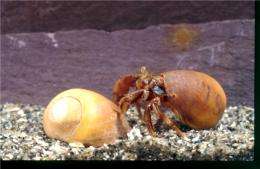A hermit crab.
(Phys.org)—A pair of researchers with Queen's University in the U.K. has found via testing, that contrary to conventional thinking, crabs appear to be capable of feeling pain. In their paper published in the journal Biology Letters, Robert Elwood and Laura Adams describe how they subjected a group of crabs to jolts of electricity and the ways they tested them to see if the shocks elicited a pain response.
In humans and a host of other vertebrates, demonstrations of pain are obvious, from cries and moans to activities related to escape to avoidance behavior afterwards. But do invertebrates and/or fish feel pain? It is a reasonable question because of the way that some invertebrates are treated by humans—dunking them, while still alive, into a pot of boiling water, for instance. Doing so to a cow, pig or chicken would be unthinkable, yet it is done routinely with crabs and lobsters, which do generally attempt to escape their fate. The conventional view is that such creatures are not able to experience pain, at least in the sense that humans feel it, because they do not have brain parts that would appear to be able to process it. But, that may be oversimplifying things—to better define if a creature experiences pain, scientists have begun to establish rules or guidelines to help, such as noting types or degree of reactionary behavior or changes in hormone levels—if such guidelines are met, the creature can be said to feel pain, in whatever form.
In this new study, Elwood and Adams set out to determine if common crabs experience pain. To find out they obtained 40 specimens and put them in plastic tanks—all had wires attached but only 20 were actually given shocks—for 200-milliseconds every 10 seconds for a two minute period. All of the crabs were watched to observe their behavior, before, during and after the shocks were applied.
The researchers report that the shocked crabs displayed more vigorous behavior than those in the control group, which included walking around, taking a threatened posture or trying to climb out of the tank. Even more tellingly, they noted that the shocked crabs experienced spiked levels of lactic acid in their haemolymph—a fluid in crabs that is analogous to blood in humans.
Taken together the evidence indicates very clearly, the team claims, that crabs do indeed feel pain.
More information: Electric shock causes physiological stress responses in shore crabs, consistent with prediction of pain, Biology Letters, Published 11 November 2015.DOI: 10.1098/rsbl.2015.0800
Abstract
Animal pain is defined by a series of expectations or criteria, one of which is that there should be a physiological stress response associated with noxious stimuli. While crustacean stress responses have been demonstrated they are typically preceded by escape behaviour and thus the physiological change might be attributed to the behaviour rather than a pain experience. We found higher levels of stress as measured by lactate in shore crabs exposed to brief electric shock than non-shocked controls. However, shocked crabs showed more vigorous behaviour than controls. We then matched crabs with the same level of behaviour and still found that shocked crabs had stronger stress response compared with controls. The finding of the stress response, coupled with previous findings of long-term motivational change and avoidance learning, fulfils the criteria expected of a pain experience.
Journal information: Biology Letters
© 2015 Phys.org























